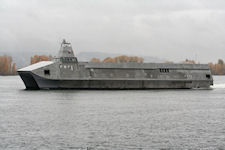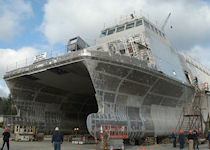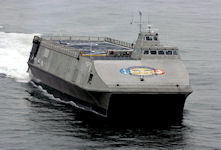Sea Fighter (FSF 1) is a test platform for concepts and technologies planned for use in the Littoral Combat Ship and is manned with a joint Navy and Coast Guard crew of only 26 personnel. The Littoral Surface Craft-Experimental LSC(X) was developed by the Office of Naval Research and christened Sea Fighter (FSF 1) on 5 February 2005. This high speed aluminum catamaran will test a variety of technologies that will allow the Navy to operate in littoral waters. Following approximately two months of trials, Sea Fighter was delivered at the end of April 2005. Operational control then was assumed by the Navy's Third Fleet with the ship operating out of its homeport of San Diego, CA.
Sea Fighter is a multi-mission test vessel designed as a proof-of-concept for numerous warfighting capabilities. Sea Fighter might prove useful enough to be the model for a new class of coastal combat ships. It is able to operate in both blue and littoral waters using either dual gas turbine engines for speed or dual diesel engines for efficient cruising. The vessel is extremely fast, with a top speed of 50-plus knots an hour. Even in rough seas (with up to 7-foot waves), the ship can do about 40-plus knots an hour. The ship has a number of capabilities such as a boat dock and a flight deck large enough for two helicopters. The ship can be easily reconfigured using interchangeable mission modules. As such, helicopters can land and launch on its deck and smaller water craft can be carried and launched from its stern
Sea Fighter is being used to evaluate the hydrodynamic performance, structural behavior, mission flexibility, and propulsion system efficiency of high speed vessels. Sea Fighter's mission flexibility will be demonstrated through interchangeable "mission modules" (standard twenty foot containers) housed in Sea Fighter's large Mission Bay. The Mission Bay is capable of housing twelve containers, permitting the vessel to be quickly reconfigured to support a variety of potential missions, including battle force protection, mine counter-measures, anti-submarine warfare, amphibious assault support and humanitarian support. A multi-purpose Stern Ramp allows Sea Fighter to launch and recover manned and unmanned surface and sub-surface vehicles up to the size of an 11 meter Rigid-Hull Inflatable Boat (RHIB). Sea Fighter will be able to simultaneously operate two MH-60S helicopters from its flight deck.
Sea Fighter will also provide a platform for the evaluation of minimum manning concepts on future naval surface ships. A base crew of 26 (Navy and U.S. Coast Guard) personnel will be responsible for all operations and basic maintenance, requiring a significant shift in the normal levels of manning currently used to accomplish various missions and tasks. Sea Fighter also will be among the first U.S. Navy ships to employ "paperless" navigation through the use of the Sperry Marine Electronic Charting and Display Information System (ECDIS) and Voyage Management System (VMS). Typically, the ship will operate with just three watchstanders and one roving patrol to monitor and configure engineering systems. This reduced manning will be supported by a level of automation and sophisticated monitoring of systems and equipment previously absent on U.S. Navy ships.
After completion of the contract design, shipyard competition, and design review in March 2003, the keel for the 262 foot-long Sea Fighter was laid in June 2003 and the 950 ton (light ship displacement) ship was launched in launched in February of 2005. After a brief period of operational evaluation and crew certification, Sea Fighter will conduct exercises in support of risk reduction for the Navy's Littoral Combat Ship (LCS) as an "LCS surrogate." Following the exercises, Sea Fighter may be upgraded with weapons and additional electronic equipment. Ultimately, Sea Fighter may be commissioned as an operational Navy ship.
The development of computational tools used for high-speed sealift, HSSL, ships requires specific data for validation. These HSSL design tools specifically address the vessel's performance and loading, including the ships behavior during wave slam events. Because very little, if any, full-scale data of this type exists, research work was obtained full-scale qualitative and quantitative wave slamming data of the Sea Fighter (FSF-1), a high-speed multihull vessel developed by the Office of Naval Research. This data included measurement of the ambient environmental conditions, the incident waves impacting the ship, ship motions, and visual documentation of the free-surface/wave field surrounding the ship during slamming events. The rough water trial took place April 18-21, 2006 and several wave slams were documented.
The Sea Fighter was built as an experiment by Nichols Bros. Boat Builders in Freeland, Washington, under contract to Titan Corporation, a subsidiary of L-3 Communications. It was ordered in 2003 and launched in 2005, 29 months from concept to a ship in the water. In 2008, the Sea Fighter was renamed the FSF-1 and commissioned for Navy duty for a total cost between $180 and $220 million.
The success of this effort can be attributed to a lack of hard requirements. The ship was intended as a research project to test design limits; it included an innovative seaframe, communications systems, and weapons configurations. The requirements document "fit on less than one page" and the designers utilized full commercial practices. The ship was commissioned under commercial American Bureau of Shipbuilding classification rules; military certification was not a factor until the ship was deployed.
The purpose of this program was to provide incentives and guidance for subsequent procurements-specifically, the LCS program. The effort demonstrated a wide range of innovative capabilities, including the previously unexplored feasibility of the aluminum hull trimaran design of the LCS2.
Solicitation N61331-10-R-0001 was for a contractor to provide the crew required to operate and maintain the FSF-1 during systems test and experimentation and during transit between ports. The Government anticipated an approximate award date of March 2010. The initial period of performance shall be from award through 12 MONTHS, thereafter, with four award terms. Each award term period, which, if awarded, extends the period of performance by 12 months. The contractor shall provide all operations, maintenance, engineering, and programmatic support required to operate and maintain the SEA FIGHTER as an experimental vessel in support of advanced technology demonstrations and Research Development, Test, and Evaluation (RDT&E) efforts. The contractor shall provide project-specific engineering, technical services, fabrication, and material procurement support as required based on specific RDT&E and advanced technology demonstration requirements taking place aboard the SEA FIGHTER.
This effort shall include, but is not limited to the following: provide engineering, maritime, and technical services to support the installation, test, inspection, checkout, maintenance, and repair of propulsion, navigation, communication, and auxiliary equipment (hereafter "equipment") for the High Speed Naval Craft SEA FIGHTER (FSF 1) Class ship. Operate the ship pier-side, at-anchor, and at-sea under its own power. Provide crew services for the Rigid Hull Inflatable Boat (RHIB) and life boat. Haul the RHIB, life boat and/other craft in and out of the water as required to support operations and maintenance. Install, checkout, test, maintain and un-install equipment/components for ship operations. Prepare, document, and conduct shipboard operations and safety training for engineering, planning, installation, and test and evaluation (T&E) personnel. Coordinate and document SEA FIGHTER specific, NSWC PCD operations processes, such as, Hurricane Evacuation Plans. Maintain configuration management plans for required SEA FIGHTER documentation. Provide food and beverage service functions for at-sea operations and special requirements, as required. Provide galley services for at-sea operations, as required.
| Ship Type | wave-piercing catamaran. |
| Name | SEA FIGHTER (FSF 1) |
| Propulsion | Two GE LM2500 Gas Turbine Engines;
|
| Length | 262 feet (79.9 meters) overall |
| 240 feet (73 meters) at waterline | |
| Beam | 72 feet (22 meters) |
| Draft | 11.5 feet (3.5 meters) |
| Full Displacement | 1600 tons |
| Light Displacement | 940-950 tons |
| Dead Weight | 640 tons |
| Hull Material | All aluminum hull |
| Speed | 50+ knots |
| Range | in excess of 4,000 nm @ 20+ knots |
| Crew | 26 (Navy and Coast Guard) |
| Homeport | San Diego, CA |
| Award Date | 02/25/2003 |
| Keel Date | 06/05/2003 |
| Launch Date | 02/05/2005 |
| Delivery Date | 05/31/2005 |
| Commission Date | not in commission |
| Build Number | S-144 |
| Builder | Titan Corporation, San Diego, CA at building yard of Nichols Brothers Boat Builders, Freeland, WA. |
| Builders | Nichols Brothers Boat Builders, 5400 South Cameron Rd, Freeland, WA 98249, USA |
| Designers | BMT Nigel Gee and Associates Ltd, Shamrock Quay, Southampton, SO14 5QL, UK |
| Class | American Bureau of Shipping (ABS) |
| Classification | A1 HSC Naval Craft OE AMS ACCU R2-S |
| Call Sign | WDC4562 |
| MMSI No | 367026670 |
| EPIRB | ADCE 0217D142401 |
| Flag Administration | NAVSEA 05D4 |
| Anchoring & Mooring Equipment Number | 633 |
| Equipment Numeral | U17 |
| Regulatory Body | IMO HSC 2000 Cargo Vessel |

by globalsecurity.org




No comments:
Post a Comment